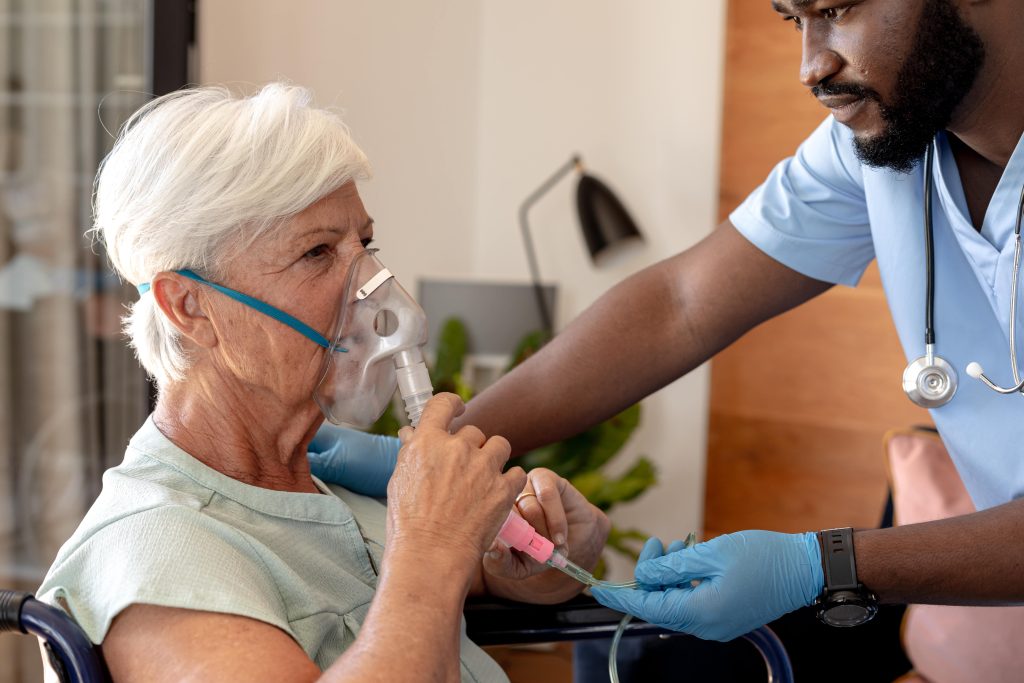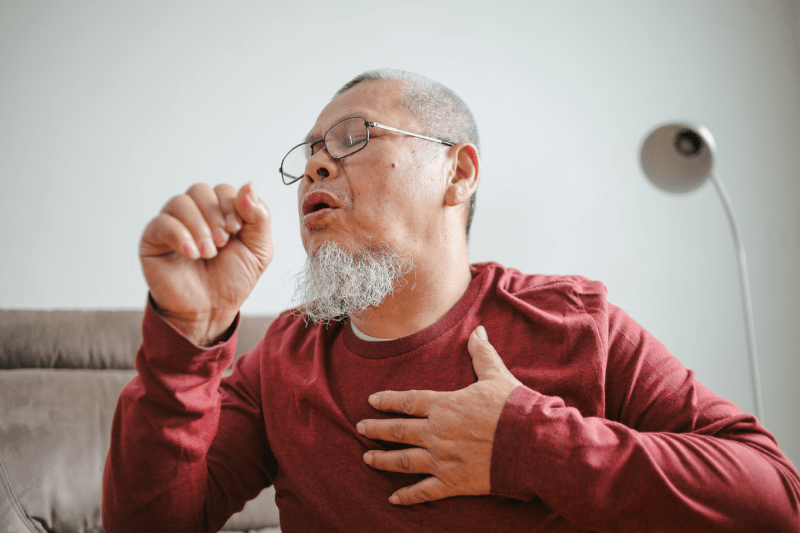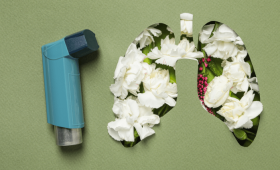Is COPD A Deadly Disease In Turkey?
Chronic Obstructive Pulmonary Disease (COPD) is one of the most common severe respiratory diseases worldwide and in Turkey. The most critical question for patients and their families is how this progressive condition affects their lifespan and quality of life. While modern medicine cannot completely eliminate COPD, with early diagnosis, advanced treatment methods, and disciplined management, it can significantly slow down the disease’s progression and meaningfully extend life expectancy. Turkey has become an important center of hope for patients by offering expertise and technology in COPD treatment at international standards.
Is COPD Truly A Deadly Disease?
COPD is, by definition, a chronic and progressive disease, meaning it worsens over time and is not fully curable. Due to this progressive nature, it can lead to fatal outcomes, especially if smoking is not quit or if the disease is left untreated. COPD is considered the fourth leading cause of death globally. However, this condition can be controlled with proper management (smoking cessation, medications, rehabilitation). The deadliness of the disease largely depends on the individual’s lifestyle decisions, the stage of the disease, and coexisting health problems.
What Is The Life Expectancy For COPD Patients?
Life expectancy for COPD patients depends on the stage of the disease, the patient’s age, and, most importantly, whether or not they quit smoking. In the early stages (GOLD 1 and 2) and in patients who quit smoking, life expectancy is quite close to normal. Even in advanced stages (GOLD 3 and 4), life expectancy and quality can be significantly improved with supportive methods such as regular inhaler therapy, pulmonary rehabilitation, and long-term oxygen therapy. In summary, a COPD diagnosis alone does not determine a definite lifespan; discipline and adherence to treatment are the decisive factors.
Which Stage Of COPD Carries A Higher Risk Of Death?
As COPD staging (GOLD system) progresses, especially Stage 3 (Severe) and Stage 4 (Very Severe) COPD carry a higher risk of death. Stage 4 signifies severe functional impairment in the lungs (FEV1), where shortness of breath occurs even at rest, and chronic respiratory failure begins. In these stages, patients become more vulnerable to infections, and the risk of heart failure (cor pulmonale) increases. This dramatically elevates the frequency of hospitalizations and, consequently, the mortality rates.
How Much Does Quitting Smoking Reduce The Risk Of Death?
Quitting smoking is the most effective, vital, and single most powerful step for COPD patients in reducing the risk of death. The moment smoking is stopped, the rate of decline in lung function approaches that of a normal, non-smoking individual. Studies show that COPD patients who quit smoking have a 30% to 40% longer life expectancy in the long term compared to those who continue. This action is also a prerequisite for the success of all medical treatments.
What Is The Most Common Cause Of Death In COPD?
The most common cause of death in COPD is generally acute respiratory failure and cardiovascular (heart and vascular) diseases. Acute respiratory failure often occurs during severe exacerbations triggered by infections (pneumonia or flu). COPD also increases the risk of heart failure (cor pulmonale) and heart attack by overloading the heart through chronic inflammation. Therefore, COPD treatment must focus not only on the lungs but also on heart health.
How Do Exacerbations Affect The Risk Of Death?
Exacerbations (acute worsening) significantly increase the risk of death in COPD patients and cause permanent deterioration in lung function. Every exacerbation may require hospitalization and can leave new damage from which the lungs may not fully recover. The prognosis for patients who frequently experience exacerbations during the year is much worse than for those who do not. The key to preventing exacerbations is regular medication use, vaccinations, and avoiding triggers (cigarette smoke, pollution).
Does Pulmonary Rehabilitation Prolong Life Expectancy?
While there is no definitive evidence that pulmonary rehabilitation directly prolongs life expectancy, it provides a significant benefit indirectly by radically improving quality of life. Rehabilitation reduces shortness of breath, increases exercise tolerance, and enables patients to participate more actively in social life. Most importantly, it prevents severe exacerbations by reducing the frequency and duration of hospitalizations. The reduced risk of exacerbation preserves the patient’s general health status and indirectly lowers the risk of death.
What Is The Risk of Heart Failure In COPD Patients?
The risk of heart failure in COPD patients is considered a high and significant comorbidity. Chronic oxygen deficiency and the narrowing of blood vessels in the lungs overload the right side of the heart (pulmonary hypertension). This condition eventually leads to right heart failure (cor pulmonale). The coexistence of heart and lung diseases increases mortality rates. Therefore, regular monitoring of heart function and the necessary cardiological treatment as part of COPD management is of vital importance.
Does Improving Quality Of Life Reduce The Risk Of Death?
Yes, focusing on improving the quality of life is the most important management strategy that indirectly reduces the risk of death in COPD. Patients whose quality of life is improved through pulmonary rehabilitation, psychological support, and effective symptom control show better adherence to treatment, and their levels of depression/anxiety decrease. This helps patients maintain their physical activity level, prevent muscle mass loss, and develop resilience against severe exacerbations, positively influencing the overall prognosis.
Is Lung Transplantation A Permanent Solution For COPD?
Lung transplantation is the last resort treatment method that offers the potential for a permanent solution for advanced-stage COPD patients. Transplantation involves replacing diseased and non-functional lungs with healthy donor lungs. This completely eliminates shortness of breath and significantly increases life expectancy. However, transplantation is a major, high-risk surgery that requires the patient to take immunosuppressive drugs for life. Therefore, transplantation is considered in cases where all other treatment options have been exhausted and the patient’s general health is suitable for the transplant.
How Vulnerable Are COPD Patients To Infections?
COPD patients are extremely vulnerable to respiratory tract infections due to chronic inflammation and damage in their lungs. The mucus clearance mechanism in the bronchi is impaired, and the lungs become a suitable environment for bacteria to settle. Even simple infections like the flu or common cold can rapidly lead to severe exacerbations and even respiratory failure in COPD patients. This vulnerability makes regular vaccination (flu and pneumonia) and avoiding crowds a vital preventive measure.
How Does Early Diagnosis Change The Mortality Rate Of COPD?
Early diagnosis is the most important factor that radically reduces the mortality rate of COPD. If the disease is diagnosed in the mild stage (GOLD 1 or 2) and the patient quits smoking, progression can be halted with treatment, and the rate of decline in lung function can be slowed down. Early treatment prevents the permanent damage in the lungs from increasing, minimizes the risk of exacerbations, and prolongs the patient’s life by years. Therefore, it is critical for individuals over 40, especially smokers, to undergo regular spirometry testing.
What Are The Fatal Risk Factors In COPD?
The most important fatal risk factors in COPD include low FEV1 value (severe functional loss), frequent exacerbations requiring hospitalization, progressive weight loss (cachexia), chronic oxygen deficiency, and coexisting heart diseases. The presence of these factors indicates that COPD is following an aggressive course and the patient’s prognosis is worsening. Each of these risk factors necessitates a more intense and careful management of the treatment plan.
Does Non-Invasive Ventilation (NIV) Prolong Life Expectancy?
Non-Invasive Ventilation (NIV) devices (e.g., BiPAP) are an important treatment tool that prolongs life expectancy in advanced-stage COPD patients with chronic respiratory failure. Especially in patients who develop respiratory failure during sleep or at rest, NIV devices allow the respiratory muscles to rest and lower carbon dioxide levels in the blood. Regular NIV use reduces hospitalizations and indirectly helps lower the risk of death by preserving the patient’s general condition.

Why Is Family Support Critically Important For COPD Patients?
Family support is critically important for COPD patients in terms of treatment adherence and psychological health. Chronic diseases can lead to depression, social isolation, and feelings of helplessness in patients. Family support helps ensure the patient takes their medications regularly, motivates them to participate in pulmonary rehabilitation programs, and helps them abstain from harmful habits like smoking. The family is a support system that directly and positively affects the patient’s quality of life and thus their prognosis.
Is There A Difference In Mortality Risk Between Asthma And COPD?
There is a significant difference in mortality risk between asthma and COPD. Asthma is a disease that develops in attacks and can usually be completely controlled and reversed with correct medications; thus, the risk of death due to asthma is rare and usually associated with inadequate treatment or delayed diagnosis. COPD, however, carries a much higher risk of death because it causes progressive and irreversible permanent damage. The primary risk in COPD is the systemic effects and comorbidities (heart failure) triggered by chronic damage over time.
How Does The Cost Of Treatment Affect Mortality Rates?
The cost of treatment can indirectly affect mortality rates, especially in developing countries or those facing economic difficulties. Restricting access to high-cost inhaler medications, long-term oxygen therapy, or pulmonary rehabilitation programs disrupts the patient’s adherence to treatment and increases the frequency of exacerbations. However, Turkey offers an economic advantage in this regard. Access to advanced treatments and quality medications at more affordable costs than Western countries facilitates treatment adherence for COPD patients, improving the prognosis.
When Does Long-Term Oxygen Therapy (LOT) Become Vital?
Long-Term Oxygen Therapy (LOT) is of vital importance for advanced-stage COPD patients with chronically low blood oxygen levels (hypoxemia). Low blood oxygen levels cause blood vessels in the lungs to narrow and strain the heart (cor pulmonale). LOT, applied for at least 15 hours a day, provides sufficient oxygen to the tissues, eases the burden on the heart, and is proven to prolong life expectancy. Therefore, LOT initiated with a doctor’s recommendation can save the patient’s life.
What Is The Risk of Heart Attack And Stroke In COPD?
The risk of heart attack and stroke in COPD patients is significantly higher than in healthy individuals. The chronic systemic inflammation caused by COPD accelerates vascular stiffness (atherosclerosis). Furthermore, low oxygen levels increase the blood’s tendency to clot, raising the risk of heart attack and ischemic stroke. Aggressive management of risk factors like cholesterol, blood pressure, and diabetes, along with primary COPD treatment, is essential to prevent these fatal cardiovascular events.
How Does Non-Adherence To Treatment Increase The Risk Of Death?
Non-adherence to treatment (irregular medication use or neglecting rehabilitation) is the behavioral factor that raises the risk of death the most in COPD. Not using regular inhaler medications leads to uncontrolled narrowing of the airways and increased inflammation. This rapidly accelerates the patient’s decline in lung function, increasing the number and severity of exacerbations. Undisciplined treatment makes the patient more prone to quick hospitalization and respiratory failure.
Which Vaccines Are Of Vital Importance For COPD Patients?
Pneumonia (pneumococcal) and flu vaccines are of vital importance for COPD patients. These vaccines aim to prevent the most common causes of COPD exacerbations, which are bacterial and viral infections. While these infections are simple for a healthy individual, they can lead to fatal respiratory failure in COPD patients. Therefore, adhering to the current vaccination schedule, especially the regular administration of the pneumonia vaccine (conjugate and polysaccharide) and the annual flu vaccine, forms the cornerstone of protective treatment.
Which Lifestyle Changes Improve The Prognosis?
Lifestyle changes that improve the prognosis in COPD are absolute smoking cessation, regular physical activity (pulmonary rehabilitation), a balanced and protein-rich diet, and avoiding triggers like air pollution. Quitting smoking halts the damage, exercise increases muscle strength and oxygen utilization, and good nutrition prevents muscle loss, enhancing general resilience. These changes ensure the patient not only survives but lives an active and high-quality life.
How Does Weight Loss (Cachexia) In COPD Affect The Risk Of Death?
Progressive and uncontrolled weight loss (cachexia) in COPD is a serious risk factor for death. The decrease in muscle mass in the body, including the respiratory muscles, weakens respiratory function and lowers the patient’s general resilience. Cachexia results from chronic inflammation and insufficient nutrition. To prevent this, special high-calorie, protein-rich diets and nutritional support are recommended for COPD patients; maintaining muscle mass is vital.
Is The Prognosis Better For Patients Diagnosed At An Early Age?
Yes, the prognosis for patients diagnosed with COPD at an early age (generally before 40-50 years old) and not due to a genetic cause can be better than for those diagnosed at an advanced age. These younger patients can usually quickly halt the decline in lung function if they quit smoking, and their bodies respond better to rehabilitation. However, the prognosis for patients diagnosed at a young age with advanced stage (e.g., those with severe alpha-1 antitrypsin deficiency) can be poor due to the aggressive course of the disease.
What Is The Contribution Of Medications Used In COPD Treatment To Life Expectancy?
Inhaler medications (bronchodilators and corticosteroids) used in COPD treatment, although they do not completely cure the disease, make significant contributions to life expectancy. Bronchodilators keep the airways open, reducing shortness of breath and enabling the patient to remain active. Inhaled steroids reduce the frequency of exacerbations, thereby lowering the patient’s risk of hospitalization and the formation of permanent damage. This indirect effect clearly increases life expectancy in patients with high treatment adherence.

Why Are COPD Treatment Centers In Turkey A Reliable Alternative?
COPD treatment centers in Turkey are a reliable alternative because they hold international JCI accreditation, possess state-of-the-art diagnostic devices (HRCT, PFT), and offer fast access to experienced chest diseases specialists. Turkey provides access to advanced treatments like pulmonary rehabilitation and minimal invasive interventions (BLVR) at much more affordable costs and without waiting periods compared to Western countries. This makes Turkey an ideal destination for international patients seeking economic advantages without compromising treatment quality.
How Does The Onset Of Respiratory Failure Increase The Risk Of Death?
The onset of respiratory failure is the most serious complication that directly increases the risk of death in COPD patients. Respiratory failure means the body cannot get enough oxygen and cannot adequately exhale carbon dioxide. This condition can lead to permanent organ damage and fatal heart rhythm disorders. When respiratory failure develops, long-term oxygen therapy and Non-Invasive Ventilation (NIV) support become vital. Treatment now aims not only for quality of life but also for the patient’s survival.
What Are The Travel And Vacation Recommendations For COPD Patients?
Recommendations for COPD patients while traveling and on vacation are important for ensuring safety. Patients are advised to avoid high altitudes (due to low oxygen levels) and stay away from extremely hot/cold weather. A doctor’s check-up before air travel and oxygen support during the flight, if necessary, can be critical. Furthermore, all medications and a health report (especially for international travel) should be carried. Planning should always prioritize comfort and safety.
Which Comorbidities Make COPD Deadly?
Comorbidities like heart failure, lung cancer, and severe pulmonary hypertension make COPD more deadly. These diseases both exacerbate respiratory failure and reduce the patient’s tolerance to treatment. Especially heart failure mimics COPD symptoms, making diagnosis difficult and doubling the risk of death. For a successful prognosis, aggressive management of COPD and all other coexisting diseases simultaneously is necessary.
What Are The Coping Methods For Shortness Of Breath In COPD Patients?
Coping methods for shortness of breath in COPD patients involve learning breathing techniques (especially pursed-lips breathing), relaxation exercises that maintain calmness during panic attacks, and strengthening muscles with pulmonary rehabilitation. Pursed-lips breathing helps maintain open airways, allowing trapped air in the lungs (air trapping) to be expelled. Since shortness of breath increases anxiety, psychological support also plays a key role in coping.
Which Nutritional Mistakes Accelerate The Progression Of The Disease?
Inadequate and unbalanced nutritional mistakes accelerate the progression of COPD. Especially inadequate protein intake leads to muscle mass loss (cachexia) and weakens the respiratory muscles. Excessive carbohydrate consumption leads to increased carbon dioxide production in the body, increasing the burden on the respiratory system and aggravating shortness of breath. Therefore, COPD patients should follow a diet consisting of small, frequent meals focused on protein and healthy fats.
What Is The Risk of Lung Cancer In COPD Patients?
The risk of lung cancer is significantly and independently higher in COPD patients compared to healthy individuals. This is due to the chronic inflammation and lung damage caused by COPD triggering cancer development. COPD is very closely linked to smoking, the biggest lung cancer risk factor. Due to this high risk, regular screening with low-dose computed tomography (LDCT) is of vital importance for COPD patients with a history of smoking.
What Is The Biggest Factor Impeding The Success Of COPD Treatment?
The biggest factor impeding the success of COPD treatment is the patient’s continuation of the smoking habit and incorrect use of inhaler medications. Smoking nullifies the effectiveness of medications and accelerates damage. Incorrect inhaler technique prevents the medication from reaching the lungs sufficiently, leading to uncontrolled symptoms. Undiscipline and incorrect use can lead to the failure of even the most expensive and advanced treatment.
Why Is Protection From Air Pollution Important In COPD?
Protection from air pollution in COPD is of great importance for preventing exacerbations and slowing the progression of the disease. Air pollution triggers inflammation and narrowing in the airways through harmful particles and gases. This increases shortness of breath and raises the risk of infection. Patients avoiding going outside on high-pollution days and using HEPA filter air purifiers at home is a protective measure.
How Does Pulmonary Hypertension Affect The Prognosis Of COPD?
Pulmonary hypertension (high blood pressure in the pulmonary arteries) negatively and seriously affects the prognosis of COPD. This condition means the right side of the heart struggles to pump blood to the lungs due to the narrowing of blood vessels. Pulmonary hypertension leads to right heart failure (cor pulmonale) and severe shortness of breath over time. Since its development significantly increases the risk of death, doctors closely monitor patients for the early diagnosis and treatment of pulmonary hypertension.
When Is Psychological Support Beneficial In COPD Treatment?
Psychological support in COPD treatment is beneficial whenever the patient experiences anxiety, depression, and panic attacks related to shortness of breath. Chronic shortness of breath can lead to patients losing joy in life, avoiding social activities, and falling into hopelessness. Support from a psychologist or psychiatrist enhances the patient’s psychological resilience, improves adherence to treatment, and plays a critical role in reducing the frequency and severity of panic attacks related to shortness of breath.
What Is The Importance Of Long-Term Follow-Up And Control Visits?
The importance of long-term follow-up and control visits is to continuously monitor the progression of the disease, evaluate treatment effectiveness, and detect potential complications early. Regular spirometry tests measure the rate of decline in lung function, while blood tests check for vitamin deficiencies or control coexisting diseases. This disciplined follow-up allows the doctor to continuously adjust the treatment plan according to the patient’s current status and supports the best long-term prognosis.
How Effective Are Tele-Medicine Solutions In COPD Treatment?
Tele-medicine solutions in COPD treatment are highly effective, especially in terms of monitoring chronic patients and the sustainability of treatment. Tele-rehabilitation sessions enable patients to exercise at home under expert supervision. Remote physician consultations reduce the need for patients to come to the hospital, offering the possibility of quick intervention, especially during periods of high exacerbation risk. These solutions allow international patients to easily receive follow-up from experts in Turkey.

What Precautions Should Be Taken By COPD Patients During Flu Season?
Precautions that should be taken by COPD patients during flu season are to get the annual flu vaccine, avoid enclosed and crowded environments as much as possible, and pay utmost attention to hand hygiene. Immediately consulting a doctor upon the first signs of the flu and starting antiviral treatment quickly is life-saving in preventing the flu from turning into a COPD exacerbation. These simple yet disciplined precautions are the key to safely navigating the winter months.
Is Stem Cell Therapy A Hope For Chronic Respiratory Failure?
Stem cell therapy for chronic respiratory failure is a promising area still in the clinical trial stage, carrying the potential to repair damaged lung tissue. Stem cells have the potential to halt the progression of COPD by reducing chronic inflammation and aiding in lung tissue regeneration. Some innovative centers in Turkey provide access to these experimental treatments. However, patients need to know that this treatment is not yet standard and that final results are awaited.
Why Is Dietitian Support Necessary For COPD Patients?
Dietitian support is necessary for COPD patients to manage the risk of cachexia, strengthen respiratory muscles, and avoid nutritional mistakes that trigger shortness of breath. The dietitian will recommend small, frequent meals that ensure adequate protein and calorie intake according to the patient’s metabolic rate and energy needs, while not increasing the respiratory load (low-carbohydrate content). This support preserves the patient’s general condition and increases their resilience to treatment.
What Are The Long-Term Benefits Of Receiving COPD Treatment In Turkey?
The long-term benefits of receiving COPD treatment in Turkey are continuous access to high-quality medications and advanced technology at a lower cost. Patients can continue pulmonary rehabilitation programs more affordably, and expert follow-up can be easily maintained through tele-medicine solutions. This economic sustainability helps patients maintain treatment discipline for life, raising their quality of life and expectancy in the long term.
What Are The Misconceptions About The Deadliness Of COPD?
The main misconceptions about the deadliness of COPD include the belief that the disease is hopeless and incurable. Yet, symptoms can be controlled and disease progression halted with modern treatments. Another misconception is the belief that it is too late to quit smoking. However, whenever smoking is quit, the decline in lung function slows down and the prognosis improves. Accurate information and discipline can overcome these misconceptions.
How Does Air Trapping In COPD Increase The Fatal Risk?
Air trapping (the inability to completely exhale air from the lungs) in COPD is a condition seen especially in emphysema patients that increases the fatal risk. Air trapping causes the lungs to become over-inflated (hyperinflation), leading to the flattening of the diaphragm and reduced efficiency of the respiratory muscles. This aggravates shortness of breath and increases the respiratory burden on the heart. Bronchoscopic interventions (BLVR) aim to reduce this air trapping, thereby improving respiratory mechanics.
Why Is The Patient’s Active Role Of Vital Importance In COPD Treatment?
The patient’s active role in COPD treatment is of vital importance because it encompasses medication adherence, rehabilitation, and full compliance with lifestyle changes. COPD is a chronic disease that must be managed by the patient themselves. Physicians provide the treatment plan, but the patient is the implementer and sustainer. Actions like quitting smoking, correct inhaler use, and regular exercise are realized by the patient’s active decisions, and these are the fundamental factors that directly determine the patient’s lifespan and quality of life.
How Should The Oxygen Need Of COPD Patients Be Planned When Traveling?
The oxygen need of COPD patients when traveling must be meticulously planned according to the type of travel and the patient’s blood gas levels. During air travel, as cabin pressure drops, a hypoxic stimulation test should be performed by a doctor to determine if the patient needs oxygen. If necessary, an appropriate portable oxygen concentrator (POC) should be requested from the airline. For road travel, a POC with sufficient battery life should be provided.
Are The Mortality Risks Different For Chronic Bronchitis And Emphysema?
Although chronic bronchitis and emphysema are both components of COPD, they may exhibit slight differences in mortality risks. Emphysema-dominant COPD (pink puffer) is often associated with heart failure (cor pulmonale) and cachexia rather than primarily respiratory failure. Chronic bronchitis-dominant COPD (blue bloater) is associated with more frequent acute exacerbations and subsequent respiratory failure. However, both carry a high risk of death in advanced stages.
What Is The Worst-Case Scenario Of Not Starting Early Treatment In COPD?
The worst-case scenario of not starting early treatment in COPD is the rapid progression of the disease to Stage 4, the development of chronic respiratory failure, and the patient becoming continuously dependent on oxygen. This severely degrades the quality of life, increases hospitalizations, and raises the risk of heart failure, significantly shortening life expectancy. Early treatment is the only way to prevent this worst-case scenario.
How Are COPD Treatment Processes Initiated In Turkey?
COPD treatment processes in Turkey are initiated by gathering all current medical reports (especially Spirometry and HRCT results) and applying to Cure Holiday, a specialized international health tourism consultancy company. Cure Holiday forwards your reports to the most experienced chest diseases specialists and advanced treatment centers in Turkey. Experts prepare a personalized treatment plan (medication, rehabilitation, possible BLVR interventions), ensuring the patient starts the most suitable treatment quickly and without a waiting period.
COPD management is a marathon, and a long distance can be covered with correct treatment and discipline. Turkey’s advanced technology centers are ready to support you with international standards throughout this challenging process.
To reach the expert team that will halt the progression of your disease, increase your quality of life, and create your personalized treatment plan, contact Cure Holiday immediately. Take your first and most important step towards healthy breathing in Turkey.


